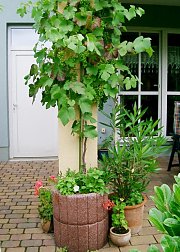Plants in Pots and Containers
As a general rule, all climbing plants can also be grown in pots or containers, especially long-bloomers/annuals. We've even dedicated a separate section just to potted grapevines. For perennials, the container-cultivation should generally remain a backup solution, because in planters they tend not to produce the desired foliage density, flowers or fruits, and overwintering can be tricky. Choose an earth planting where possible and lead the plant to the balcony from the ground. On a rooftop terrace, or if it is not possible to plant directly from the ground, the plants will have to make do with a container. The advantage: since the vigour of a potted plant is limited, easy or light wire rope systems are usually sufficient as supports.

Plant Pots
Your container should be able to hold at least 10-30 litres, have good drainage (to prevent any standing water), and be protected during winter. Place it in as shady a spot as possible and give it a water drain of some kind (like a layer of pebbles/gravel at the bottem), since many plants don't like to have "wet feet." For this reason, don't put any saucers under the pots either! On wooden decks or balconies, it is best to prop the pot up on some bricks to avoid potential water damage to the wood. Topsoil or a mixture of equal parts sand, clay, and compost make for the the best soil. A layer of regularly replenished mulch can prevent the soil from drying out.
Winter Protection
Many damages that occur in winter are not caused directly by the cold but by dehydration; that is, as temperatures drop, most people forget to water their plants. The soil dries out because most people also don't think about the evaporation factor and neglect to rehydrate their plants. Note: evergreen plants (e.g. and some climbing roses) transpire ~lose their water through evaporatation ~ and need to be watered even in winter!
The best way to overwinter plants in containers is to water them moderately again after the leaves have fallen and then place the container in a hole in the ground before covering it thickly with earth and leaves, straw, or pine branches so that only the stems of the plant protrude. From March / April, the pots can be placed back in their usual spot.
As an alternative, the pot can be wrapped with bubble wrap or something similar to avoid heat peaks from temporary sunshine (which may trigger in the plant a false feeling of rising soil temperatures and the 'beginning of spring'). You don't want your plant to perceive spring prematurely! However, this packing/insulation cannot prevent the pot from cooling down to the ambient air temps during particularly cold nights. A grapevine, for example, which hasn't lost too much of its vitality by bearing excessive fruit during the summer, can tolerate temperatures down to -20º C and below. Please Note: overwatered planters can freeze and crack/burst.






